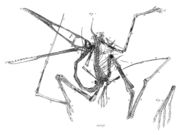Alpha taxonomy

Alpha taxonomy is the science of finding, describing and naming species of living or fossil organisms.[1] The term "alpha" refers to alpha taxonomy being the first and most basic step in taxonomy. This science is supported by institutions holding collections of these organisms, with relevant data, carefully curated: such institutes include Natural History Museums, Herbaria and Botanical Gardens.
Contents |
Describing species

A formal description of a species follow certain rules. From a collection of organisms, one or more typical specimen if available are selected as basis for the description. In living species where specimen are easily obtainable, these should ideally represent bout adult and young individuals. Often they are not however, and with fossil specimen, the basis for the descriptin can be fragmentary and often the only known specimen available. These are designated type specimen, and are to be kept as reference for the species in a special type collection. Mammals and birds are often kept as skin and skeletons (sometimes only the skull). Insects are commonly kept as dried specimen, other animals are often preserved whole in alcohol or formaldehyde. Plants are preserved flattened and dry in herbaria.
For the new species to be valid, the formal description must be published in a scientific journal. Several journals exists devoted to publishing of new species. The description of a species will contain a description of typical features of the organisms, and how it differ from other similar organisms. The new species is given a binominal name according to scietific naming conventions, usually accompanied by a formal biological classification giving Kingdom, Phylum or Division, Class, Order, Family, Genus, and Species.[2] Special rules apply in botany, where a formal description must have a summary in Latin giving a brief description of the shape of leaves and flowers.
Auctors
An alpha taxonomist is called an auctor, from the scolastic term for author. The auctor will have to be intimately familiar with previously published scientific literature on the group, to avoid describing an already named species or using a name that is taken. This literature can span centuries and several languages, making alpha taxonomy very much the realm of specialists.[1]
Once a species (or any other taxonomic unit) is named, the name of the auctor is associated with the description. The full formal name of a species will contain not only the Latin binominal, but also the name of the original auctor and the year of the original publication. While the name of a species my change (usually by the species being transferred to a new genus, the auctor name and year still apply.
Names of certain very prolific auctors are sometimes abbreviated. Many of the more well known species of plants and animals were described by Carl Linnaeus in his Systema Naturæ. The full formal name of for example the tiger is "Panthera tigris, (L 1758)", were the L stands for Linnaeus.
Alpha taxonomy and systematics
For a long time the term "taxonomy" was used for what is today seen as alpha taxonomy. Over time, the term "taxonomy" has gained several other meanings and has thus became potentially confusing. To some extent it is being replaced, in its original (and narrow) meaning, by "alpha taxonomy". As such, alpha taxonomy deals mostly with real organisms: species and lower ranking taxa. Higher ranking taxa (including clades and grades) mostly are the province of "beta taxonomy", more commonly called systematics. Systematics (as a science) deals with the relationships between taxa, especially at the higher levels. These days systematics is greatly influenced by data derived from DNA from nuclei, mitochondria and chloroplasts. This is sometimes known as molecular systematics which is becoming increasingly more common, perhaps at the expense of traditional taxonomy.[3].
_KL.jpg)
See also
- Alternative taxonomical classification
- Biology
- Biological classification
- Biological kingdom chart
- Cladistics
- Evolutionary tree
- Important publications in taxonomy
- Integrated Taxonomic Information System
- Systematics
- Taxon
References
- ↑ 1.0 1.1 Fortey, R. (2008): Dry Store Room No. 1: The Secret Life of the Natural History Museum. Harper Perennial, London. ISBN-10: 0007209894
- ↑ International Code of Botanical Nomenclature, (St. Luis code), Electronic version, Chapter I, article 3
- ↑ Wheeler, Q. D. (2004). Taxonomic triage and the poverty of Phylogeny. Phil. Trans. Roy Soc. London, Biology 359: 571-583.
External links
- uBio Taxonomic Name Reconciliation
- Integrated Taxonomic Information System - Generalized N. American server Mexico Server Canada Server
- Tree of Life
- BioLib
- NCBI Taxonomy
- Taxonomy & Informatics An AMNH & NSF Project
- Merriam-Webster Online Dictionary: definition- taxonomy Ü
- The Nature of Plant Species - article on a study by University Bloomington scientists
- Aphia: North Sea flora and fauna taxonomic register
- VisualTaxa: Taxonomic subdivision of life